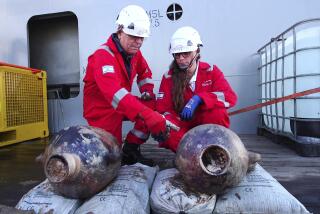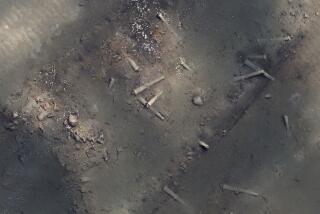World’s ‘oldest shipwreck’ found at bottom of Black Sea
- Share via
Reporting from Berlin — Over the past 600 years, Europe’s Black Sea has been one of the maritime areas hit hardest by war and nationalism. Bordering Turkey, Russia and Ukraine, among other nations, the inland body of water’s trade routes were dominated by the Ottoman Turks after they occupied Constantinople in 1453. It was a key battlefield during World War II and has once again become contested, with Ukraine and Russia clashing there in recent years.
But there was a time when trade flourished in the Black Sea. And on Tuesday, European researchers revealed some stunning details about a period when Greek ships crossed the Bosporus strait, loaded with goods to trade and risking storms and natural disasters.
One such ship has now been discovered almost completely intact at the bottom of the Black Sea at a depth of 1.2 miles, where oxygen levels are so low that marine life is virtually nonexistent. While animals and bacteria would usually decompose a wooden shipwreck’s remains within centuries, the 75-foot-long Greek shipwreck lay undisturbed for more than 2,400 years, researchers with the Black Sea Maritime Archaeology Project said Tuesday.
“The Black Sea is considered to be one of the world’s finest under water laboratories,” the team wrote on its website.
The Greek trading ship was the oldest of dozens of shipwrecks that were discovered off the coast of Bulgaria during the three-year project, which the team claims is the biggest effort of its kind. The findings are documented in a two-hour documentary, which is also due to be released Tuesday.
Using deep-sea diving robots and sonar from ships, the researchers scanned the bottom of the Black Sea, primarily looking for possible ruins of submerged ancient settlements to study the effects of melting glaciers on sea levels. But as they mapped over 770 square miles of seafloor, more than five dozen historical vessels — almost all of them astonishingly well preserved — appeared before the cameras of their remote-controlled underwater vehicles. The team believes that some of the ships were once operated by the Romans, with other vessels dating to the 17th century.
“Over 60 shipwrecks, varying in age from a 17th century Cossack raiding fleet, through Roman trading vessels complete with amphorae to a complete ship from the Classical period, were found across the 3-year period,” the team wrote in a statement.
The researchers have focused in particular on the ancient Greek ship, of which only a small part was removed from the original location to confirm the wood’s radiocarbon age. There are no plans to recover the entire wooden structure, partially over fears that it would break apart. The researchers have also not released its exact location.
But the discovery could still yield some remarkable insights into an era from which few wooden remnants are still intact.
“This will change our understanding of shipbuilding and seafaring in the ancient world,” said research project team member Jon Adams.
Noack writes for the Washington Post.
More to Read
Sign up for Essential California
The most important California stories and recommendations in your inbox every morning.
You may occasionally receive promotional content from the Los Angeles Times.










